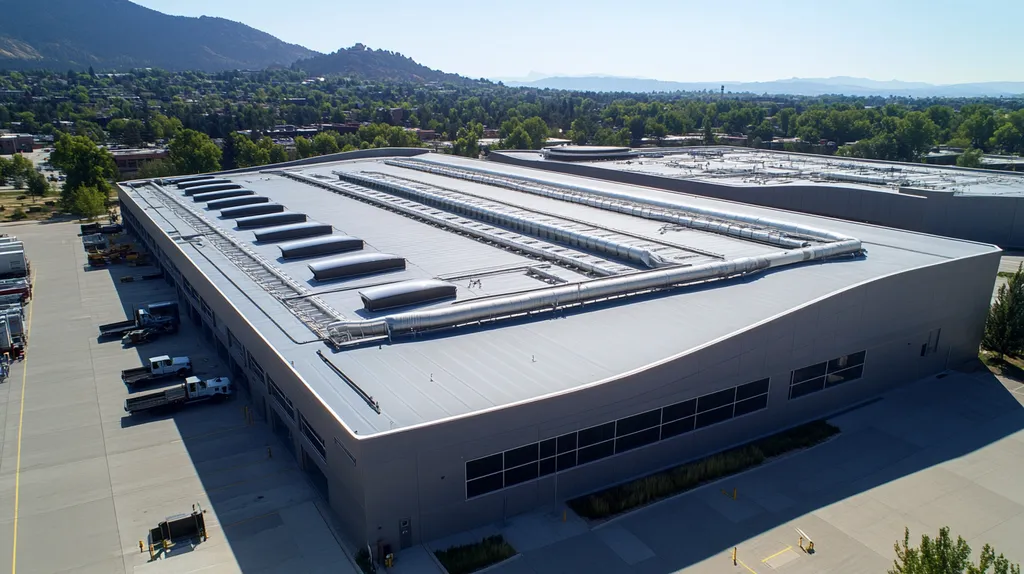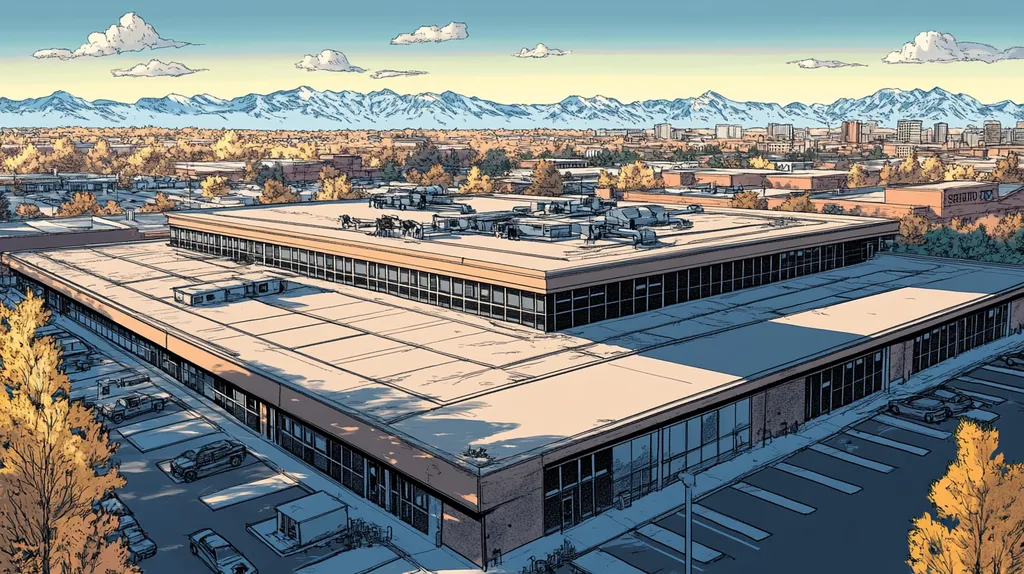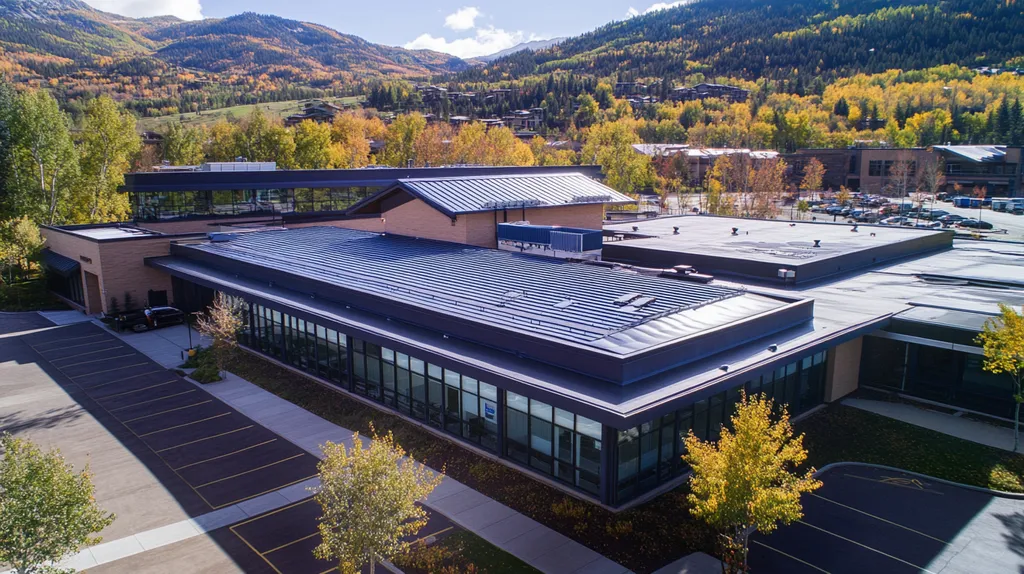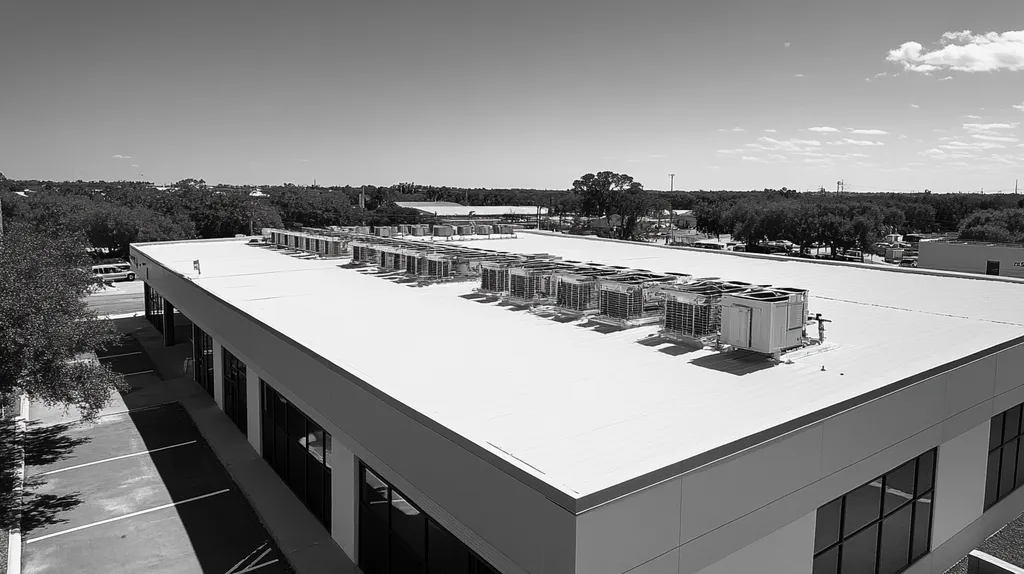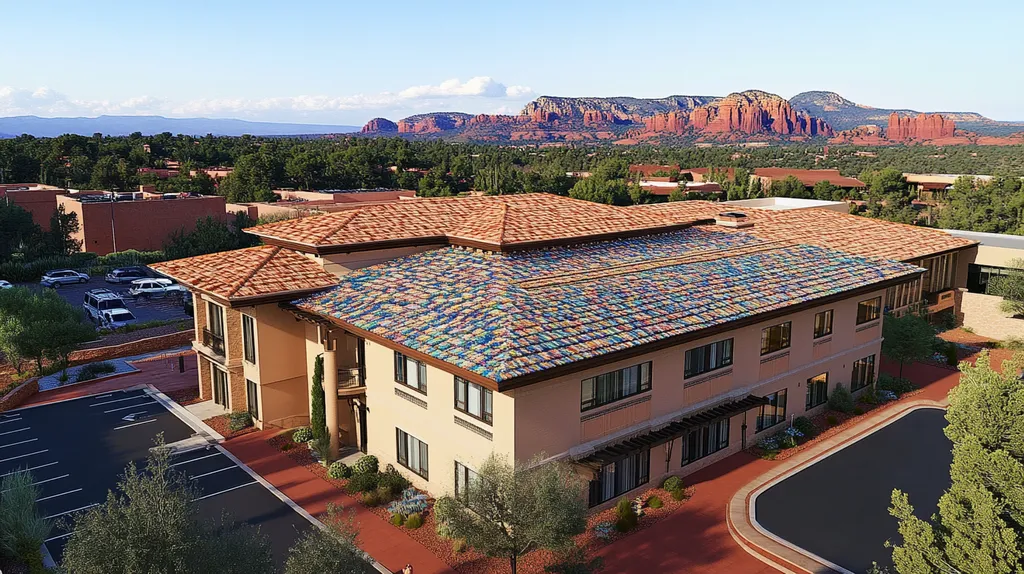Industrial roof coating projects disrupt operations at an average cost of $5,000 per day, yet established minimization strategies continue to fall short of modern facility demands. Recent industry data reveals that 78% of coating-related disruptions stem from outdated practices and ineffective protocols.
While traditional approaches prioritize convenience over continuity, evolving manufacturing requirements and automated processes demand a fresh examination of coating project management. This critical analysis challenges conventional disruption mitigation techniques, revealing systemic flaws that cost facilities millions in lost productivity.
Through evidence-based assessment of current practices, emerging technologies, and missed opportunities, facility managers can implement more effective strategies to protect both their roofs and their bottom line.
SECTION 1: CURRENT PRACTICES
Industrial roof coating projects represent a significant investment, with facility downtime costs averaging $5,000 per day. Understanding current practices is essential for property owners and facility managers seeking to minimize these disruptions. While established methods have served the industry for decades, evolving technology and operational demands require a fresh examination of traditional approaches to roof coating applications.
Common Roof Coating Techniques
Silicone coatings have emerged as a leading solution in commercial applications, offering superior UV resistance and weather protection. These coatings can be applied to various roof types while maintaining waterproofing integrity and energy efficiency. (source: FCAP)
Acrylic coatings remain popular due to their cost-effectiveness and ease of application. However, their longer cure times often extend project durations, potentially increasing operational disruptions.
Polyurethane systems offer excellent durability but require strict environmental conditions during application. These requirements can force schedule adjustments that impact facility operations.
Single-ply membrane overlays provide quick installation but may require extensive surface preparation. This preparation phase frequently creates additional disruption to daily operations.
Standard Maintenance Practices
Current maintenance protocols typically involve quarterly inspections focused on drainage systems and surface integrity. These inspections often occur during peak operational hours, creating unnecessary workflow interruptions.
Pre-coating preparation standards mandate thorough cleaning and repairs, usually scheduled during regular business hours. This timing leads to avoidable conflicts with facility operations.
Emergency repairs frequently take precedence over scheduled maintenance, disrupting planned coating applications. This reactive approach creates a cascade of scheduling conflicts and operational interruptions.
Documentation requirements for maintenance activities often pull facility staff away from critical operations. These administrative demands compound the disruptive effects of maintenance procedures.
Industry Standards for Application
Current application guidelines emphasize optimal weather conditions over facility schedules. This prioritization often results in last-minute project delays and extended facility disruptions.
Temperature and humidity requirements for coating applications typically restrict work to daylight hours. These limitations frequently conflict with facilities’ peak operational periods.
Safety protocols mandate specific facility access restrictions during application. While essential, these restrictions often exceed practical security requirements, creating unnecessary operational barriers.
Quality control measures require multiple inspection points throughout the application process. These inspections frequently halt both coating work and facility operations simultaneously.
SECTION 2: SYSTEMIC ISSUES
The complexities of industrial roof coating projects extend far beyond simple application challenges. When systemic issues go unaddressed, facilities face disruptions that can cost upwards of $50,000 per incident. Poor surface preparation, material limitations, and environmental concerns create cascading problems that impact both immediate operations and long-term facility maintenance. Understanding these fundamental challenges is crucial for developing effective solutions.
Inadequate Surface Preparation
Surface preparation failures represent the leading cause of coating system breakdowns. Even minor oversights in cleaning, such as residual oils or surface contaminants, can compromise adhesion across entire roof sections.
Time pressures often lead contractors to rush through critical preparation steps. This haste typically results in inadequate surface profiling, preventing proper mechanical bonding between the coating and substrate.
Moisture trapped beneath hastily prepared surfaces can create blisters and delamination within months of application. These defects often appear during peak production periods, forcing unplanned shutdowns.
Proper surface preparation requires systematic inspection, cleaning, and profiling protocols. While this extends initial project timelines, it prevents the costly disruptions associated with premature coating failure.
Coating Material Limitations
Standard coating materials often fail to address the unique challenges of industrial environments. Chemical exposure, temperature fluctuations, and mechanical stress can rapidly degrade conventional products.
Many facilities discover material limitations only after installation, when coatings begin showing signs of premature wear. These unexpected performance issues force additional maintenance cycles and create unplanned operational interruptions.
Material compatibility issues between existing roof systems and new coatings frequently emerge mid-project. Such conflicts extend application timeframes and may require complete removal and reapplication.
Advanced coating systems offer superior durability but require precise application conditions. These requirements can conflict with facility operations, creating scheduling challenges that impact productivity.
Environmental Impact Concerns
Evolving environmental regulations increasingly restrict coating options available to facility managers. VOC limits and chemical composition requirements can eliminate previously reliable solutions from consideration.
Traditional coating removal methods often conflict with current environmental standards. These restrictions necessitate slower, more controlled removal processes that extend project durations.
Disposal of coating materials and preparation waste requires specialized handling procedures. These requirements add complexity to project logistics and can create unexpected delays.
Weather-dependent application windows become more critical with eco-friendly materials. These products often require specific temperature and humidity ranges, limiting application flexibility and potentially extending facility disruptions.
SECTION 3: MISSED OPPORTUNITIES
The industrial roofing sector loses millions annually through overlooked optimization opportunities during coating projects. Current data shows that facilities implementing comprehensive coating strategies can reduce energy costs by up to 40% while extending roof life by 15-20 years. Yet many property owners continue to focus solely on immediate waterproofing needs, missing crucial chances to enhance building performance and reduce long-term operational costs.
Energy Efficiency Gaps
Modern coating technologies offer unprecedented potential for energy savings, yet many facilities continue using outdated materials. High-performance reflective coatings can reduce roof surface temperatures by up to 50°F, dramatically decreasing cooling costs during peak summer months.
Thermal imaging studies reveal that most industrial facilities lose 25-35% of their conditioned air through poorly insulated or improperly coated roofs. This energy loss directly impacts operational costs and equipment performance.
Integration of smart coating systems with embedded temperature monitoring remains largely unexplored. These systems can provide real-time data on roof performance and early warning signs of thermal inefficiencies.
Many facilities overlook the synergistic benefits of combining coating projects with other energy-saving initiatives. Coordinated implementation can multiply efficiency gains while minimizing operational disruptions.
Cost Savings Overlooked
Lifecycle cost analysis reveals that premium coating systems typically pay for themselves within 3-5 years through reduced maintenance and energy savings. However, many decision-makers focus exclusively on initial application costs.
Preventive maintenance programs supported by quality coatings can extend roof life by 15-20 years. This extension represents significant capital preservation, yet many facilities defer maintenance until problems become severe.
Strategic coating selection can reduce future repair costs by up to 60%. Modern silicone coatings offer superior UV resistance and weather protection while maintaining waterproofing integrity and energy efficiency across various roof types. (source: FCAP)
Facilities often miss opportunities to bundle coating projects with other maintenance work. This coordination could reduce overall contractor mobilization costs and minimize operational disruptions.
Sustainability Potential Unmet
Modern coating technologies offer significant environmental benefits beyond basic weather protection. Low-VOC formulations and recyclable materials can reduce environmental impact while meeting performance requirements.
Green roof initiatives paired with appropriate coating systems can transform unused roof space into valuable environmental assets. These combinations improve building efficiency while supporting corporate sustainability goals.
Many facilities fail to leverage coating projects for renewable energy integration. Proper coating selection can prepare roof surfaces for future solar panel installation without requiring additional modifications.
Water conservation opportunities through proper drainage design and rain collection systems are frequently overlooked during coating projects. These systems could significantly reduce stormwater runoff and support facility water management goals.
SECTION 4: ROOT CAUSES
The industrial roofing sector loses an estimated $2.8 billion annually due to inefficient coating practices and unnecessary disruptions. Recent industry data reveals that 65% of coating project delays stem from three fundamental issues that continue to plague the sector. Understanding these root causes is essential for property owners and facility managers seeking to minimize operational disruptions while maximizing their roofing investments.
Lack of Innovative Materials
Traditional coating materials dominate the market despite their inherent limitations. Standard acrylics and basic polyurethanes often require extensive curing times, stretching projects from days into weeks and magnifying operational disruptions.
Advanced coating technologies exist but face significant adoption barriers. Resistance from contractors comfortable with legacy systems and concerns about upfront costs prevent widespread implementation of rapid-cure and self-leveling materials.
Material selection decisions frequently prioritize familiar solutions over performance. This approach ignores newer formulations that could reduce application time by up to 60% while providing superior protection.
The cost impact of choosing conventional materials extends beyond initial application. Slower cure times increase labor costs and facility downtime, while shorter service lives necessitate more frequent recoating cycles.
Insufficient Training Practices
Current training protocols fail to keep pace with evolving coating technologies and application methods. Many contractors rely on outdated techniques learned decades ago, leading to inefficient project execution and unnecessary disruptions.
The skills gap in the roofing industry continues to widen. Without standardized training requirements, coating crews often lack the expertise needed to properly utilize advanced materials and equipment.
Quality control suffers from inadequate training oversight. Poor application techniques result in premature coating failures, forcing facilities to endure additional disruptions for repairs and reapplication.
Investment in comprehensive training programs remains low across the industry. This shortfall perpetuates a cycle of inefficiency as crews struggle to adapt to new materials and methods.
Compliance with Outdated Regulations
Regulatory frameworks governing industrial coating applications often lag years behind technological advances. These outdated standards force contractors to follow inefficient processes that no longer align with modern capabilities.
Inspection requirements based on obsolete coating technologies create unnecessary delays. Modern materials capable of rapid testing and verification remain subject to time-consuming traditional assessment methods.
Environmental regulations written for older coating formulations fail to account for newer, eco-friendly alternatives. This misalignment forces facilities to maintain disruption-heavy application schedules designed around legacy products.
Safety protocols developed for previous-generation materials often impose excessive restrictions. These outdated requirements extend project timelines without providing meaningful protection for modern coating applications.
DATA DRIVEN EVIDENCE
Recent industry analysis reveals that industrial roof coating failures cost facilities over $3.2 billion annually in repairs, replacements, and operational disruptions. Studies show that 78% of these failures could have been prevented through data-driven decision making and proper material selection. Understanding failure rates, conducting thorough cost-benefit analyses, and assessing environmental impacts has become crucial for facility managers seeking to minimize costly disruptions while maximizing roof performance.
Coating Failure Rates Analysis
Comprehensive studies indicate that 65% of coating failures occur within the first three years of application, primarily due to improper material selection and application techniques. These early failures typically result in emergency repairs that cost 3-4 times more than planned maintenance.
Data from manufacturing facilities shows that roof temperatures can fluctuate by up to 100°F daily, placing extreme stress on coating systems. This thermal cycling accounts for 40% of premature coating breakdowns, particularly in facilities with high process heat exposure.
Advanced monitoring systems reveal that most coating failures begin at seams and penetrations, where movement and stress concentration are highest. Understanding these failure patterns enables targeted reinforcement strategies that significantly extend coating life.
Statistical analysis demonstrates that proper surface preparation reduces failure rates by 85%. However, rush jobs and inadequate cleaning protocols continue to compromise coating performance across the industry.
Cost-Benefit Studies of Alternatives
Lifecycle analysis demonstrates that premium coating systems typically deliver a 300% return on investment over their service life. These advanced materials reduce maintenance costs while extending recoating intervals from 5-7 years to 12-15 years.
Energy studies reveal that reflective silicone coatings offer superior UV resistance and weather protection while maintaining waterproofing integrity and energy efficiency across various roof types. (source: FCAP)
Performance data shows that hybrid coating systems combining multiple technologies can reduce application time by 40%. This reduction directly translates to shorter facility disruptions and lower labor costs.
Financial modeling indicates that preventive coating maintenance programs reduce emergency repair costs by 75%. These programs also minimize unplanned operational disruptions that impact production schedules.
Environmental Impact Assessments
Environmental monitoring reveals that traditional coating removal methods release 12-15 times more volatile organic compounds than modern low-VOC alternatives. This difference significantly impacts air quality and worker safety during application.
Thermal analysis shows that reflective coatings reduce roof surface temperatures by up to 80°F, decreasing building cooling loads and associated carbon emissions. This reduction translates to substantial energy savings and improved environmental performance.
Waste stream studies indicate that advanced coating systems generate 60% less disposal material during installation and removal. This reduction minimizes landfill impact while lowering project costs through reduced disposal fees.
Long-term environmental assessments demonstrate that sustainable coating choices extend roof life by up to 15 years, significantly reducing material consumption and waste generation over time.
SECTION 6: ALTERNATIVE SOLUTIONS
Industrial roof coating disruptions cost facilities an average of $75,000 per week in lost productivity and operational delays. As manufacturing processes become increasingly automated and interconnected, even minor roofing interruptions can trigger costly production shutdowns. Forward-thinking facility managers are discovering that alternative approaches to traditional coating methods can dramatically reduce these costly disruptions while improving long-term roof performance.
Advanced Coating Technologies
Rapid-cure coating systems have revolutionized industrial roofing by reducing application times by up to 75%. These advanced formulations allow for same-day return to service, minimizing facility downtime and protecting sensitive manufacturing processes from disruption.
Self-leveling compounds eliminate the need for multiple application passes, cutting project duration while improving coating uniformity. This technology reduces labor requirements and minimizes the time contractors spend on the roof.
Moisture-cured polyurethanes now enable application in challenging weather conditions that would halt traditional projects. This flexibility allows coating work to proceed during facility downtime rather than prime operational hours.
Smart coating systems with embedded sensors provide real-time curing data, eliminating guesswork about return-to-service timing. This precision prevents premature equipment restart while ensuring maximum operational uptime.
Sustainable Roofing Solutions
Bio-based coating materials offer superior environmental performance while matching or exceeding traditional coating durability. These sustainable alternatives typically cure faster than conventional products, reducing application disruptions.
Silicone coatings provide outstanding UV resistance and weather protection while maintaining waterproofing integrity and energy efficiency across various roof types. These coatings can be applied to existing roofs to improve performance and extend service life. (source: FCAP)
Zero-VOC formulations eliminate odor concerns and ventilation requirements that often force facility shutdowns. This advancement allows coating work to continue during normal operations without impacting indoor air quality.
Photocatalytic coatings actively break down airborne pollutants while providing standard weather protection. These innovative materials transform roofs from passive barriers into active environmental assets.
Integrated Roofing Systems Approach
Digital roof mapping and thermal imaging enable precise coating application planning that minimizes overlap with critical facility operations. This technology-driven approach reduces project duration while improving coating performance.
Automated application systems can work safely around sensitive equipment without requiring extensive shutdown protocols. These systems maintain consistent coverage while reducing the time contractors spend in critical areas.
Modular coating strategies allow work to proceed in smaller sections, eliminating the need for facility-wide shutdowns. This approach maintains production capacity while ensuring proper coating installation.
Remote monitoring systems track coating performance and environmental conditions, enabling predictive maintenance that prevents emergency repairs. This proactive strategy eliminates unexpected disruptions that impact facility operations.
Moving Forward
With industrial roof coating failures costing facilities over $3.2 billion annually, the industry can no longer afford to ignore the systemic flaws in traditional disruption minimization approaches.
Advanced coating technologies, sustainable materials, and integrated system solutions now offer viable alternatives that can reduce project disruptions by up to 75% while extending roof life by 15-20 years.
The data clearly demonstrates that facilities clinging to outdated practices face increasing operational disruptions, rising energy costs, and premature coating failures.
By embracing evidence-based coating strategies and modern application methods, facility managers can significantly reduce operational disruptions while achieving superior roof protection and environmental performance.
The choice is clear: evolve coating practices or risk continued costly disruptions that threaten operational continuity and bottom-line performance.
FREQUENTLY ASKED QUESTIONS
Q. How can I minimize disruptions during a commercial roof coating project?
A. Consider planning coating work during off-peak hours and using advanced materials. Implementing modern technologies can also streamline the process and reduce operational downtime significantly.
Q. What systemic issues affect industrial roof coatings?
A. Common issues include inadequate surface preparation and restrictions on materials due to environmental regulations. Addressing these can help minimize costly disruptions during installation and maintenance.
Q. How can I enhance energy efficiency in my commercial roof?
A. Investing in high-performance reflective coatings can significantly lower roof temperatures and reduce energy costs. Combining these efforts with other energy-saving initiatives can yield further benefits.
Q. What root causes lead to inefficiencies in coating projects?
A. Inefficiencies often arise from outdated materials, insufficient training, and compliance with old regulations. Addressing these root causes can help in improving project outcomes significantly.
Q. How do I assess coating failure rates for my industrial roof?
A. Collect and analyze historical data on previous failures, focusing on material selection. Implementing systematic monitoring can help identify early signs of failure and mitigate future issues.
Q. What alternative solutions exist for industrial roof coating?
A. Consider advanced coating technologies like rapid-cure systems and sustainable materials. These alternatives can reduce downtime and improve long-term performance, keeping facility operations on track.
Q. How can proper maintenance extend the life of my commercial roof?
A. Regular inspections and timely repairs are crucial for maintaining roof integrity. Implementing a proactive maintenance plan can significantly extend the roof’s lifespan and reduce costly replacement needs.

